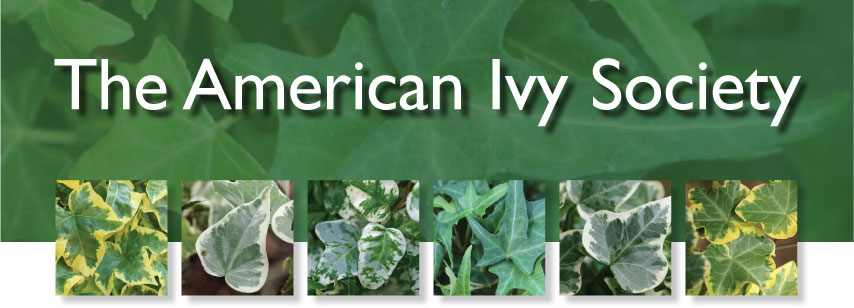Cloning Your Ivies
By
Dr. Charles W. Dunham
Professor Emeritus, University of Delaware
Plants propagated vegetativly are genetically identical to the parent plant from which they originated and therefore are a clone. Most all ivy cultivars have originated from a single parent plant and make up clonal groups. Vegetative propagation means using a part of a plant to form a whole new plant. Layering and stem cuttings are types of vegetative propagation used to clone or propagate ivy.
The ability of cells in stems to form roots instead of the normal leaves and buds is related to the kind of plant, the maturity of the stem in the current growing season and the stage of maturity of the stem in the plants life cycle. In the current growing season all plants go through periods of growth and rest. In their life cycle all plants go through a juvenile stage when they are unable to form flowers and set seed. This stage can last from weeks or years in different plants . In ivy it is often about ten years. This stage is often characterized by different leaf shapes and habits of growth. Most of the ivies we grow are in the juvenile stage that is characterized by a viny habit of growth and lobed leaves. Juvenile plants have cells that can regenerate new tissues and organs easier than those in mature plants. The stems of juvenile ivy plants have cells just below each node (a node is the point where leaves and buds occur) that have the ability to form roots very quickly This is one of the reasons ivies are so easy to propagate from layers and cuttings.
PROPAGATING IVY BY LAYERING
Layering is the easiest and surest way of propagating your ivy. When an ivy runner comes in contact with moist soil roots push out through the stem from cells in areas just below the nodes. This happens regularly and naturally when ivy is planted in the ground outdoors. When a potted ivy is sunk in the soil any time during the summer months and the runners are pinned down with a wire staple so that the runners are in contact with the soil and the soil is kept moist, roots will emerge all along the stem in the area just below the nodes. These runners can then be carefully lifted and cut apart and the new plants potted individually or groups of three or more. Use one of the soiless potting mixes like Pro mix or Ready Earth. Then give the plants the care required by any new tender plant. This means keep out of strong sunlight, water regularly and apply only very weak or no fertilizer at all until plants are established.
PROPAGATING BY CUTTINGS
Layering is surer but sometimes propagating by stem cuttings is more convenient. For one thing it can be done at any time of year although periods of rest following active growth spurts are best. Make your cuttings about three inches long, make the cut about one quarter inch below a node and strip off all of the leaves on the lower inch of the stem. Insert the cuttings in pots or flats about one inch deep filled with one of the soiless mixes. Water the cuttings thoroughly. A good way to do this is place them in a tray of water until water rises to the top of the soil. Place the plants in indirect light either indoors or out or under fluorescent lights and cover with cheese cloth or burlap for about a week until the cuttings get hardened a little. Water regularly so that the cuttings do not dry out. They should root in one to two months. Then they should be handled the same as newly potted layered plants.
ROOTING CUTTINGS IN WATER
Ivies root very readily in water. Use larger cuttings than in media and strip all of the leaves that will be below the waterline. Water should be no more than three inches deep. Place the cuttings in indirect light or a north facing window. After roots form care is needed in establishing the new plants in a potting media. Roots formed in water lack root hairs that are necessary for the cuttings to absorb water from soil or other media. Use a mixture of one part soiless media and two parts horticultural grade perlite. Water well and place in a plastic storage bag for a few days and then gradually open the bag to acclimate them to the outside air. This gives time for new root hairs to form.
